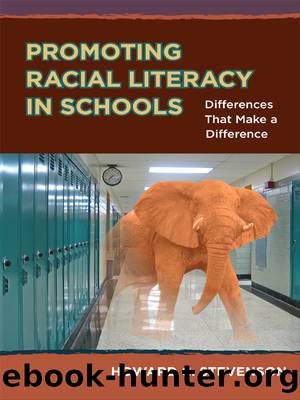Promoting Racial Literacy in Schools by Howard Stevenson

Author:Howard Stevenson
Language: eng
Format: epub
Publisher: Teachers College Press
Published: 2014-03-15T00:00:00+00:00
Facing and Recasting Racial Stress Through Racial Literacy
Exposing students to diverse ethnic foods or learning the meaning of the colors of the flags of different countries doesnât adequately prepare students for negotiating a diverse world. Still, how do students navigate the world of racial stereotyping? As institutions of higher learning, why canât classrooms represent the spaces where these and other social challenges are raised and debated? Instead of students, parents, and teachers reproducing these stereotypes through avoidance, how can these groups be taught to psychologically face and counter these stereotypes? Racial literacy, racial debate, and racial negotiation are cornerstone skills for students and educators alike, but they must be taught with a relevance to the current needs of education, with a focus on addressing the racial fears and specific task demands of educators and constituents, and for the problem solving of current societal challenges.
Rist (1970) identifies how the power of teacher interactions in blocking the social opportunities of students is not dissimilar from how societal barriers and hierarchies of privilege create social injustice and disparities. There are disparities in the ways teachers approach children of color, even in affluent White schools. Classroom interactions emulate societal discrimination and apprehension about racial risk taking. A major premise of this book is that teachers and students are stressed by unspoken challenges or adherences to a racial hierarchy that are observable through the social interactions in the classroom (Thompson & Schultz, 2003). Whether a student raises his hand to share his ideas while worrying that others may see his contribution as racially tainted or whether a teacher decides to continue a discussion that falls surreptitiously into the realm of âwho has the right to use the âNâ wordâ are a few examples of stressful interactions that might tax teachersâ and studentsâ coping abilities. These âelephantsâ loom larger for students or teachers of color, who are often stereotypically framed as less able to learn or teach. The same could be true of teachers and students of any racial background who have to engage racially stressful interactions. Yet I would distinguish between the stress related to the challenges and practices of teaching students and the stress of teaching Black and Latino students. Student and teacher racial stress may best be subsumed in the following questions: âHow well can I perform in my schoolwork as a Black student or in my teaching of Black students?â âIs the stress of performing competently in my teaching of Black students or of being one of the few Black students in my classroom overwhelming?â
Although I believe racial stress and incompetence hinders teaching and learning, I have been impressed with some teachers, students, parents, and educational leaders who are racially assertive regardless of the racial composition of the audience. My research over the last several years has begun to uncover behavioral expressions of racial suppression and assertiveness among students and faculty in schools. Coleman and Stevenson (2013) developed measures that specifically ask teachers in predominantly White independent schools about their racial socialization
Download
This site does not store any files on its server. We only index and link to content provided by other sites. Please contact the content providers to delete copyright contents if any and email us, we'll remove relevant links or contents immediately.
| Arts & Humanities | Health |
| Language Arts | Library Skills |
| Mathematics | Reading & Phonics |
| Science & Technology | Social Studies |
The Art of Coaching Workbook by Elena Aguilar(51000)
Trainspotting by Irvine Welsh(21521)
Twilight of the Idols With the Antichrist and Ecce Homo by Friedrich Nietzsche(18510)
Fangirl by Rainbow Rowell(9106)
Periodization Training for Sports by Tudor Bompa(8173)
Change Your Questions, Change Your Life by Marilee Adams(7639)
This Is How You Lose Her by Junot Diaz(6800)
Asking the Right Questions: A Guide to Critical Thinking by M. Neil Browne & Stuart M. Keeley(5654)
Grit by Angela Duckworth(5525)
Red Sparrow by Jason Matthews(5392)
Paper Towns by Green John(5092)
Room 212 by Kate Stewart(5041)
Ken Follett - World without end by Ken Follett(4647)
Housekeeping by Marilynne Robinson(4349)
The Sports Rules Book by Human Kinetics(4299)
Double Down (Diary of a Wimpy Kid Book 11) by Jeff Kinney(4209)
Papillon (English) by Henri Charrière(4199)
The Motorcycle Diaries by Ernesto Che Guevara(4018)
Exercise Technique Manual for Resistance Training by National Strength & Conditioning Association(3960)
